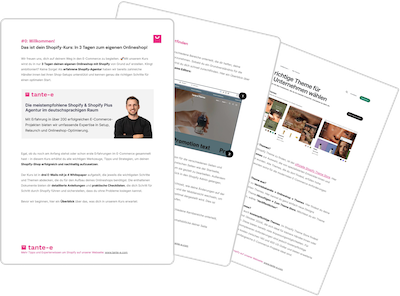The question of whether retailers should use Shopify themes or a headless setup is something we're increasingly seeing at tante-e. Many brands face precisely this dilemma – often with the assumption that headless automatically means more flexibility, better performance, or a future-proof setup.
However, in discussions with our customers, in workshops, and at project launches, we notice that expectations and reality are often out of proportion. The supposed advantages of a headless approach often bring with them a whole new set of complexities in practice.
In this article, we share our experiences from both worlds. We show when headless can actually make sense and why we consciously choose the Shopify Storefront in most cases.

The article's insights are based on the insights of tante-e founder and Shopify expert Adrian. In the tante-e podcast, he regularly speaks with our experts on the most relevant topics related to Shopify.
1. What does headless mean on Shopify – and what is Shopify Hydrogen?
Headless means that the frontend—the visible interface of the store—is technically completely decoupled from the backend. Content, product data, and functions are provided via APIs, and the frontend can be built independently using modern frameworks like React. This provides virtually unlimited design possibilities. However, the effort involved also increases accordingly.
Shopify has developed its own framework for headless storefronts, Hydrogen. Hydrogen is based on React and provides a development foundation specifically for e-commerce. It's aimed at teams with technical experience who want to develop highly customized storefronts. Shopify also provides the appropriate hosting infrastructure with Oxygen.
1.1. Differences between Shopify Themes & Headless
| criterion | Shopify Theme | Shopify Hydrogen (Headless) |
|---|---|---|
| technology | HTML, CSS, Liquid | React + Shopify APIs |
| Setup effort | Low – ready to use | High – individual development process necessary |
| Hosting & Maintenance | Included with Shopify | Self-responsible (e.g. via Oxygen or externally) |
| Team requirements | Can also be used without developers | Only feasible with developers |
| flexibility | High, v. a. with Shopify OS 2.0 | Maximum – complete control over the frontend |
| App integration | Plug and play via App Store | Manual API integration required |
| Long-term effort | Minor, covered by Shopify updates | High – ongoing maintenance & further development required |
| output | Resources for an appealing look & feel | High investment in background processes and technology that customers do not immediately notice, in fact: less budget and resources for a convincing storefront |
Hydrogen enables full control over the storefront, including complex animations, custom data manipulation, and external CMS integrations. However, it also brings with it technological requirements that not every team can handle—and not every brand needs.
2. The advantages of Shopify themes – from project practice
For many brands, Shopify themes are the most practical way to implement a powerful and professional online store. In our daily work, we repeatedly experience how the advantages of Shopify Storefronts come into play, especially when teams want to work quickly, flexibly, and independently.
Why we prefer Shopify themes:
-
Speed at start:
A Shopify store can go live in days—not weeks or months. This is a huge advantage, especially for brands with a clear product vision and a direct sales focus. -
Intuitive usability:
The Theme Editor allows you to maintain and customize content, layouts, and structures directly in the admin interface, even without in-depth technical knowledge. -
Maintenance included:
Shopify handles hosting, security, updates, and stability. No DevOps, no server issues, no separate deployment. -
Compatibility with the Shopify ecosystem:
Apps, payment providers, extensions – everything can be connected directly. No custom integrations or technical detours required. -
Cost efficiency:
Themes reduce both initial and ongoing development costs. For many brands, they're a key factor in budget and resource planning. -
Independence for teams:
Content teams in particular benefit: Changes can be implemented without external support. This saves time, money, and stress.
Which themes do we recommend most? Learn all about our top themes on Shopify .
Additional bonus: Flexibility with Shopify OS 2.0
With the introduction of Shopify Online Store 2.0, the customizability of themes has been significantly expanded – for example, through:
- Flexibly customizable sections
- Dynamic content areas
- Improved app integration
- Metafield management directly in the admin
For many use cases that were previously only possible with headless, there are now actually native solutions in the Shopify theme ecosystem. And in our experience, these are often simpler, faster, and more sustainable.
3. Experience with Headless
At first glance, headless sounds like freedom, performance, and maximum design freedom. In practice, however, we regularly hear that the supposed increase in flexibility comes with significant limitations in everyday life – both on a technical and organizational level. Accordingly, our agency work focuses exclusively on Shopify. We pass on headless project requests to our partners out of conviction. In the following section, we summarize the key reasons for this.
Typical challenges in headless projects
-
High development effort:
A lot of custom programming is done – from the basic structure of the storefront to every feature that comes standard with Shopify themes. -
Complex infrastructure:
Headless means not only a separate frontend, but also additional tools, middleware, hosting environments, and interfaces. This increases the risk of errors and requires specialized support. -
Rising costs:
Longer development times, ongoing maintenance and repairs result in significantly higher initial and operating costs. -
Slow everyday life:
Content and marketing teams lose the ability to adapt content independently. Even small changes must be handled by developers—which delays processes and ties up resources. -
Technical dependencies:
Headless projects often lead to heavy dependence on agencies or IT. Without an internal development team, the store quickly becomes a black box. -
Maintenance effort:
For traditional storefronts, Shopify handles hosting, updates, and security. With headless, this responsibility lies entirely with the operator. -
Incompatibility with Shopify Apps:
Many apps cannot be used directly, but must be integrated manually – including interfaces, logic and frontend display.
Adrian says:
"Headless introduces the kind of sluggishness we were trying to avoid. Suddenly, the brand needs an IT team again—not to grow, but to share content."
The freedom of the headless approach brings with it responsibility for setup, operation, and further development. This usually involves areas that Shopify storefronts often reliably cover.
4. Practical examples: When it (doesn’t) work
Whether headless or Shopify Storefront, practical experience quickly reveals how viable a store architecture truly is. These concrete examples illustrate the differences.
4.1. Beurer: Headless with a clear objective

The family-owned company Beurer deliberately opted for a headless setup with Composable Commerce – and successfully implemented it. The starting point was a complex setup with international requirements, multiple brands, specific regulatory requirements, and a multitude of connected systems.
What distinguishes the project:
- Central code base for all countries and brands
- Flexible connection to various microservices
- International scalability across one architecture
- Headless frontend with own framework & hosting via Makaira
- Clear project methodology (agile, feature-based, with MVP focus)
Thanks to the team's technical expertise, clear objectives, and structured implementation, Beurer was able to use Headless productively and efficiently – not as an end in itself, but because it fit the organizational structure and the highly complex requirements.
Michael Singer from Beurer shared more information about the headless implementation at the Merchant Inspiration Talks 2024 .
4.2. nkm: Back to the Shopify Storefront

Things were different for nkm – naturkosmetik münchen . The brand had originally opted for a headless setup. They hoped for more freedom in designing the storefront. However, the opposite happened: the dependence on the agency and the daily maintenance effort grew so much that nkm decided to return to the native Shopify storefront. The reason: With Shopify OS 2.0, the team could implement many of the desired features without a headless setup – faster, easier, and more independently.
What improved with the change:
- Significantly lower technical maintenance effort
- Simplified content maintenance directly in the admin
- Less agency dependency for minor changes
- More efficient work for the internal team
You can find out more about the nkm shop in our detailed case study .
4.3. Lady Gaga: Headless Frontend, Shopify Checkout

Another interesting case study is Lady Gaga's headless store, which Shopify itself presented as a reference project. The storefront features a custom-developed frontend with animated elements and a strong visual focus.
Nevertheless, checkout and customer accounts continue to run via the standard Shopify solutions. Here, too, it's clear that key functions from the Shopify core system are being used – and complete decoupling isn't always necessary or desirable. Headless is being used specifically where it adds value – and combined with proven standards where they prove their worth.
4.4. XbyX: Less administrative effort thanks to Shopify

Another practical example is XbyX . The brand initially opted for a separate solution: The store ran on Shopify, while content such as blogs, guides, and other content was maintained on an external CMS. The goal was to use a content-optimized platform to achieve SEO benefits.
However, the reality was different:
- High maintenance effort due to parallel systems
- Difficult tracking and inaccurate data because different platforms do not work together optimally
- More complex editorial processes and longer coordination processes
The consequence: XbyX decided to bring the entire content area back to Shopify.
The result:
- Performance remained the same or even improved
- Significantly lower maintenance requirements
- Better tracking and more consistent data basis
This also shows that a native setup with Shopify can be not only simpler but also more effective in many cases – even in highly content-driven cases.
You can find out how XbyX successfully integrates content and commerce on Shopify in the case study .
4.5. How Headless became a mistake for Paul Valentine
A particularly impressive example is the story of Paul Valentine : Within just a few years, the brand grew to over €30 million in revenue through strong performance and influencer marketing. However, this rapid success was not accompanied by a stable infrastructure. On the contrary: Internal processes, cost control, and technological clarity lagged behind the growth.
Part of the challenge: A headless setup was introduced, but without the desired added value. Looking back, founder Paul Franzreb cites the headless attempt as one of the most costly mistakes:
“We had implemented headless commerce for a while, which looked good on paper, but didn’t deliver the desired effect – and created a lot of complexity and cost.”
The result: The company had to file for bankruptcy in 2023. Paul Franzreb shares all the details in an episode of the Snocksulting podcast .
5. Conclusion: Not what is possible, but what makes sense
The same applies to Shopify stores: Not everything that's feasible is also sensible. The difference between Shopify Storefront and Headless isn't just technical—it's strategic.
Our experience has shown time and again that Shopify themes offer the optimal balance of flexibility, scalability, and efficiency for most brands. They enable a quick start, easy maintenance, and direct access to the entire Shopify ecosystem.
Headless can be the right choice if requirements are clearly defined, resources secured, and the technical prerequisites are met. But these prerequisites are rarely a given.
Our recommendation: Don't base your decisions on current trends, but rather on your own vision. Don't ask yourself what's theoretically possible. Instead, ask yourself: What will actually move your shop forward?


